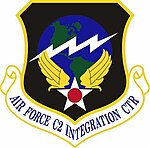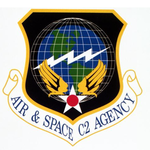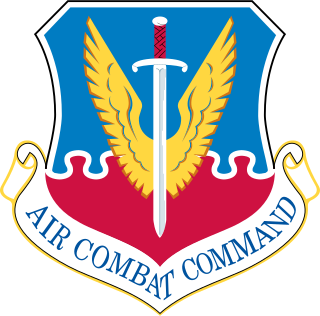
The Air Combat Command (ACC) is one of nine Major Commands (MAJCOMs) in the United States Air Force, reporting to Headquarters, United States Air Force (HAF) at the Pentagon. It is the primary provider of air combat forces for the Air Force, and it is the direct successor to Tactical Air Command. Air Combat Command is headquartered at Langley Air Force Base, Joint Base Langley–Eustis, Virginia, United States.

The Sixteenth Air Force (Air Forces Cyber) (16 AF) is a United States Air Force (USAF) organization responsible for information warfare, which encompasses intelligence gathering and analysis, surveillance, reconnaissance, cyber warfare and electronic warfare operations. Its headquarters is at Joint Base San Antonio-Lackland in Texas.

The 2nd Space Operations Squadron is a United States Space Force unit responsible for operating the Global Positioning System (GPS) satellite constellation, which provides global navigation, time transfer, and nuclear detonation detection. It is a component of Space Operations Command's Positioning, Navigation, and Timing Integrated Mission Delta (Provisional) and headquartered at Schriever Space Force Base, Colorado.

The 480th Intelligence, Surveillance, and Reconnaissance Wing is headquartered at Langley Air Force Base, Virginia.

The 67th Cyberspace Operations Group is a unit of the 67th Cyberspace Wing. Headquartered on Kelly Field Annex's Security Hill, the group is an Air Force information operations unit.

The 544th Intelligence, Surveillance and Reconnaissance Group is a United States Air Force unit assigned to the Air Combat Command Sixteenth Air Force. It is stationed at Buckley Space Force Base, Colorado. It was reactivated under the 70th Intelligence, Surveillance, and Reconnaissance Wing on 26 September, 2022.

The 940th Air Refueling Wing is part of the Air Reserve Component of the United States Air Force. It is assigned to the Fourth Air Force of the Air Force Reserve Command, is operationally-gained by the Air Mobility Command, and is home stationed at Beale Air Force Base, California.

The United States Air Force's 9th Combat Operations Squadron is an Air Force Reserve Command space operations unit located at Vandenberg Space Force Base, California. The 9th augments the 614th Air and Space Operations Center in operating the Joint Space Operations Center, performing combat operations, plans, strategy and intelligence assessments that enable the Commander, Joint Functional Component Command for Space to command and control space forces by providing worldwide space effects and theater support to combatant commanders.

The United States Air Force's 688th Cyberspace Wing is a cyberspace operations unit located at Kelly Field Annex, Joint Base San Antonio-Lackland, Texas. It was first organized in July 1953 as the Air Force Special Communications Center. It produced long term intelligence information and developed intelligence gathering techniques. Losing its communications intelligence functions, it focused on electronic warfare, and in July 1975 was redesignated the Air Force Electronic Warfare Center. As its mission grew to include all elements of the spectrum, it became the Air Force Information Warfare Center in September 1993 and the Air Force Information Operations Center in October 2006. In 2009, it was reassigned from the intelligence community to Air Combat Command and became the 688th Information Operations Wing, assuming its current name in September 2013.

The 16th Airborne Command and Control Squadron was a United States Air Force squadron assigned to Air Combat Command's 461st Air Control Wing, 461st Operations Group, stationed at Robins Air Force Base, Georgia. The squadron previously flew the Northrop Grumman E-8C JSTARS, providing airborne battle management, command and control, surveillance, and target acquisition with the last E-8C flight on September 8, 2022.

The 363d Intelligence, Surveillance and Reconnaissance Wing is a United States Air Force unit. The wing is assigned to the United States Air Force Sixteenth Air Force, stationed at Joint Base Langley-Eustis, Virginia.

Richard E. Webber is a retired United States Air Force major general. He was the first commander of the Twenty-Fourth Air Force, which was focused on cyberspace operations. The Twenty-Fourth Air Force was located in San Antonio, Texas, and was stood up in place of the originally proposed larger Major Command organization, Air Force Cyber Command. Webber graduated from the United States Air Force Academy in 1975 and has worked in the space and missile career field.

The United States Air Force's 543d Intelligence, Surveillance and Reconnaissance Group is an intelligence unit located at Joint Base San Antonio, Texas. It has been located there since 1997, when it was activated as the 543d Intelligence Group. It focuses on cryptologic operations and signals intelligence.
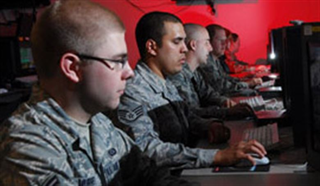
The United States Air Force's 497th Intelligence, Surveillance and Reconnaissance Group is an intelligence unit located at Joint Base Langley–Eustis, Virginia.
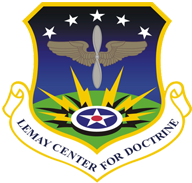
The Curtis E. LeMay Center for Doctrine Development and Education

Twenty-Fifth Air Force, also known as Air Force Intelligence, was a numbered air force (NAF) within the United States Air Force (USAF), and served as the Air Force's premier military intelligence organization. 25 AF was established on 29 September 2014 by redesignating the Air Force Intelligence, Surveillance and Reconnaissance Agency under Headquarters, United States Air Force, to a numbered air force aligned under Air Combat Command. The USAF also realigned the 9th Reconnaissance Wing and the 55th Wing under the new NAF. It was headquartered at Lackland Air Force Base, Texas.

The 27th Intelligence Squadron is an active squadron of the United States Air Force, stationed at Langley Air Force Base, part of Joint Base Langley-Eustis, near Hampton, Virginia. It is assigned to the 480th Intelligence, Surveillance and Reconnaissance Wing.

The 67th Cyberspace Wing is a United States Air Force wing stationed at Lackland Air Force Base, Texas. It was activated in October 1993 as a military intelligence unit and is assigned to the Sixteenth Air Force.

The 30th Intelligence Squadron is an active United States Air Force unit, stationed at Langley Air Force Base, Virginia and operating Distributed Ground Station-1 in association with reserve and Virginia Air National Guard squadrons.

Space Operations Command (SpOC) is the United States Space Force's space operations, cyber operations, and intelligence field command. Headquartered at Peterson Space Force Base, Colorado, it consists of its mission deltas, and garrison commands.
